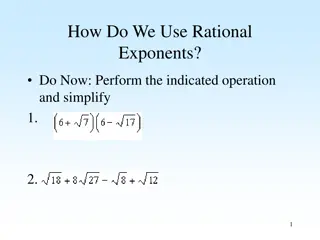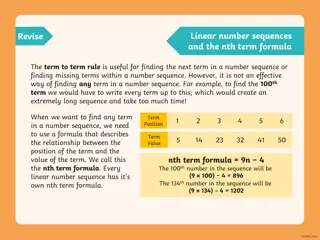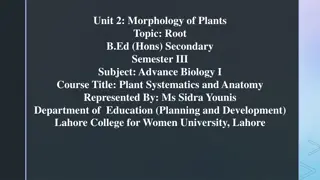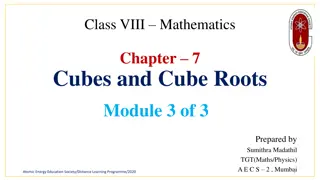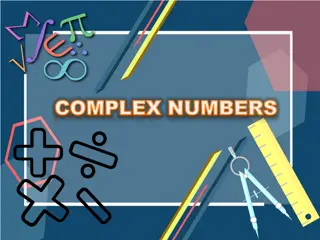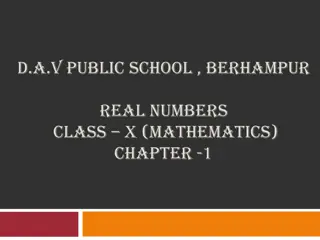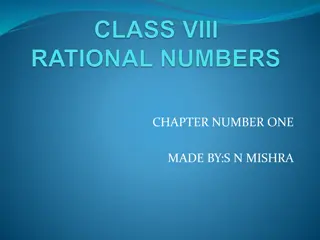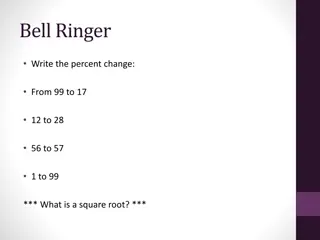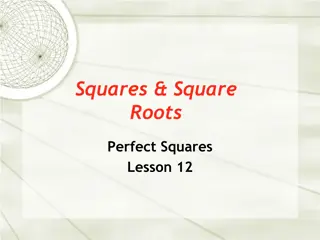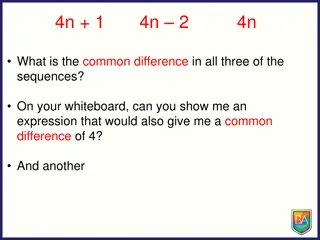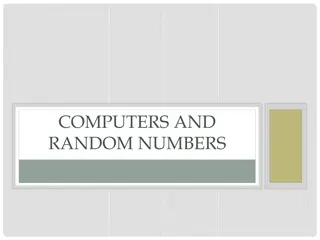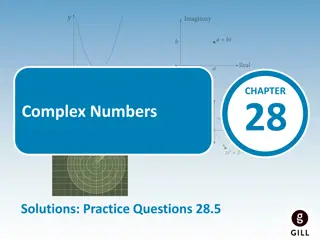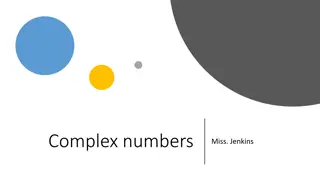
Finding Nth Roots of Complex Numbers and Representing Solutions on an Argand Diagram
Learn how to apply De Moivre's theorem to find the Nth roots of complex numbers, explore real and imaginary roots, and represent solutions on an Argand diagram. Solve equations like z3 = 1 by expressing numbers in modulus-argument form and calculating cosine and sine parts using trigonometry.
Download Presentation

Please find below an Image/Link to download the presentation.
The content on the website is provided AS IS for your information and personal use only. It may not be sold, licensed, or shared on other websites without obtaining consent from the author. If you encounter any issues during the download, it is possible that the publisher has removed the file from their server.
You are allowed to download the files provided on this website for personal or commercial use, subject to the condition that they are used lawfully. All files are the property of their respective owners.
The content on the website is provided AS IS for your information and personal use only. It may not be sold, licensed, or shared on other websites without obtaining consent from the author.
E N D
Presentation Transcript
Teachings for Teachings for Exercise 1F Exercise 1F
?(???? + ?????)?= ??????? + ?????? ? ??: ? = ? cos(? + 2??) + ????(? + 2??) Complex Numbers ??: ? = ? ???? + ????? You can use De Moivre s theorem to find the nth roots of a complex number You already know how to find real roots of a number, but now we need to find both real roots and imaginary roots! We need to apply the following results: 1) If: ? = ? ???? + ????? Then: where k is an integer ? = ? cos(? + 2??) + ????(? + 2??) This is because we can add multiples of 2 to the argument as it will end up in the same place (2 = 360 ) 2) De Moivre s theorem ?(???? + ?????)?= ??????? + ?????? 1F
?(???? + ?????)?= ??????? + ?????? ? ??: ? = ? cos(? + 2??) + ????(? + 2??) Complex Numbers ??: ? = ? ???? + ????? Im In this case the modulus and argument are simple to find! You can use De Moivre s theorem to find the nth roots of a complex number Solve the equation z3 = 1 and represent your solutions on an Argand diagram. ? = 1 1 Re ? = 0 First you need to express z in the modulus-argument form. Use an Argand diagram. ?3= 1 ???0 + ????0 Apply the rule above Cube root (use a relevant power) Apply De Moivre s theorem Now we know r and we can set z3 equal to this expression, when written in the modulus-argument form ?3= cos(0 + 2??) + ????(0 + 2??) 1 3 ? = cos 0 + 2?? + ????(0 + 2??) We can then find an expression for z in terms of k 0 + 2?? 3 0 + 2?? 3 ? = cos + ???? We can then solve this to find the roots of the equation above 1F
?(???? + ?????)?= ??????? + ?????? ? ??: ? = ? cos(? + 2??) + ????(? + 2??) Complex Numbers ??: ? = ? ???? + ????? 0 + 2?? 3 0 + 2?? 3 ? = ??? + ???? You can use De Moivre s theorem to find the nth roots of a complex number k = 0 Sub k = 0 in and calculate the cosine and sine parts Solve the equation z3 = 1 and represent your solutions on an Argand diagram. ? = ??? 0 + ???? 0 ? = 1 We now just need to choose different values for k until we have found all the roots k = 1 2? 3 2? 3 ? = ??? + ???? Sub k = 1 in and calculate the cosine and sine parts The values of k you choose should keep the argument within the range: - < ? = 1 3 2+ ? 2 k = -1 Sub k = -1 in and calculate the cosine and sine parts (k = 2 would cause the argument to be outside the range) So the roots of z3 = 1 are: ? = ??? 2? + ???? 2? 3 3 ? = 1, 1 2 and 1 3 3 2+ ? 2 ? 2 ? = 1 3 2 ? (these are known as the cube roots of unity (ie 1)) 2 1F
?(???? + ?????)?= ??????? + ?????? ? ??: ? = ? cos(? + 2??) + ????(? + 2??) Complex Numbers ??: ? = ? ???? + ????? Im You can use De Moivre s theorem to find the nth roots of a complex number ? ? ?+ ? ? Solve the equation z3 = 1 and represent your solutions on an Argand diagram. 2 3? ? Re 2 3? We now just need to choose different values for k until we have found all the roots 2 3? ? ? ? ? The values of k you choose should keep the argument within the range: - < ? The solutions will all the same distance from the origin So the roots of z3 = 1 are: The angles between them will also be the same ? = 1, 1 2 and 1 3 3 2+ ? 2 ? 2 The sum of the roots is always equal to 0 1F
?(???? + ?????)?= ??????? + ?????? ? ??: ? = ? cos(? + 2??) + ????(? + 2??) Complex Numbers ??: ? = ? ???? + ????? ? = 1 3 2+ ? You can use De Moivre s theorem to find the nth roots of a complex number 2 Square 2 ?2= 1 3 2+ ? b) Show that the three cube roots of 1 can be written as 1 + ? + ?2 where 1 + ? + ?2= 0 2 Expand bracket ?2=1 3 4+ ?23 3 4 ? 4 ? 4 The roots of z3 = 1 are: Simplify ? = 1, 1 2 and 1 3 3 ?2=1 4 3 3 2+ ? 2 ? 4 2? 2 4 Simplify more ?2= 1 3 2 ? Let ? = 1 3 2 (ie the second of the roots) 2 2+ ? 1 + ? + ?2= 0 Replace terms 1 + 1 2 1 3 3 2+ ? 2 ? = 0 2 1F
?(???? + ?????)?= ??????? + ?????? ? ??: ? = ? cos(? + 2??) + ????(? + 2??) Complex Numbers ??: ? = ? ???? + ????? You can use De Moivre s theorem to find the nth roots of a complex number This result will be very important next lesson! 2??? ? for ? = 1,2..? 2?? ? 2?? ? In general, the solutions to ??= 1 are ? = ??? + ???? = ? These are known as the nth roots of unity If ? is a positive integer, there will be a root of unity ? such that: The roots can be written as 1,?,?2 ?? 1 1 + ? + ?2+..+?? 1= 0 (we just showed an example of this) The roots 1 + ? + ?2 will form the vertices of a regular polygon (more on this next lesson!) 1F
?(???? + ?????)?= ??????? + ?????? ? ??: ? = ? cos(? + 2??) + ????(? + 2??) Complex Numbers ??: ? = ? ???? + ????? Im Find the modulus and argument You can use De Moivre s theorem to find the nth roots of a complex number r 2 22+ 2 3 2 3 ? = 4 ? = Solve the equation ?4 2 3? = 2 Re ? = ??? 12 3 ? =? 2 2 3 Give your answers in both the modulus- argument and exponential forms. ? 3 ? 3 ?4= 4 ??? By rearranging ?4= 2 + 2 3? + ???? Apply the rule above Take the 4th root of each side ? 3+ 2?? + ???? ? 3+ 2?? ?4= 4 ??? As before, use an argand diagram to express the complex number in the modulus-argument form 1 4 ? 3+ 2?? + ???? ? 3+ 2?? 4 ? 3+ 2?? 4 ? 3+ 2?? ? 3+ 2?? 4 ? 3+ 2?? 4 ? = 4 ??? De Moivre s Theorem Work out the power at the front 1 4 ??? ? = 4 + ???? Then choose values of k until you have found all the solutions ? = 2 ??? + ???? 1F
?(???? + ?????)?= ??????? + ?????? ? ??: ? = ? cos(? + 2??) + ????(? + 2??) Complex Numbers ??: ? = ? ???? + ????? ? 3 4 ? 3 4 You can use De Moivre s theorem to find the nth roots of a complex number Sub k = 0 in and simplify (you can leave in this form) ? = 2 ??? + ???? k = 0 ? 12 ? 12 ? = 2 ??? + ???? Solve the equation ?4 2 3? = 2 ? 3+ 2? 4 ? 3+ 2? 4 ? = 2 ??? + ???? k = 1 Give your answers in both the modulus- argument and exponential forms. 7? 12 7? 12 ? = 2 ??? + ???? Choose values of k that keep the argument between and By rearranging ?4= 2 + 2 3? ? 3 2? 4 ? 3 2? 4 ? = 2 ??? + ???? k = -1 2 ??? 5? + ???? 5? ? = As before, use an argand diagram to express the complex number in the modulus-argument form 12 12 ? 3 2? 4 ? 3 2? 4 ? = 2 ??? + ???? ? 3+ 2?? 4 ? 3+ 2?? 4 k = -2 ? = 2 ??? + ???? 2 ??? 11? + ???? 11? ? = 12 12 Then choose values of k until you have found all the solutions 1F
?(???? + ?????)?= ??????? + ?????? ? ??: ? = ? cos(? + 2??) + ????(? + 2??) Complex Numbers ??: ? = ? ???? + ????? Solutions in the modulus-argument form You can use De Moivre s theorem to find the nth roots of a complex number 2 ??? 5? + ???? 5? ? 12 ? 12 ? = ? = 2 ??? + ???? 12 12 2 ??? 11? + ???? 11? 7? 12 7? 12 Solve the equation ?4 2 3? = 2 ? = ? = 2 ??? + ???? 12 12 Give your answers in both the modulus- argument and exponential forms. Solutions in the exponential form ? 12? 2? 5? 2? 11? 12? ? = 2? ? = By rearranging ?4= 2 + 2 3? 7? 12? 12? ? = 2? ? = As before, use an argand diagram to express the complex number in the modulus-argument form ? 3+ 2?? 4 ? 3+ 2?? 4 ? = 2 ??? + ???? Then choose values of k until you have found all the solutions 1F
?(???? + ?????)?= ??????? + ?????? ? ??: ? = ? cos(? + 2??) + ????(? + 2??) Complex Numbers ??: ? = ? ???? + ????? Im Find the modulus and argument You can use De Moivre s theorem to find the nth roots of a complex number 2+ 4 2 2 ? = 8 ? = 4 2 ???? = 3? Solve the equation: 4 2 Re 4 ?3+ 4 2 + 4? 2 = 0 4 2 r Rearrange ?3= 4 2 4? 2 Sketch the complex number on an argand diagram For the angle, since the lengths are equal, ? = 45 =? 4 So the argument will be equal to 3? 4 You can also solve these problems using the exponential form ?3= 4 2 4? 2 Write using the exponential form ?3= 8? 3? 4? 1F
?(???? + ?????)?= ??????? + ?????? ? ??: ? = ? cos(? + 2??) + ????(? + 2??) Complex Numbers ??: ? = ? ???? + ????? ?3= 8? 3? 4? You can use De Moivre s theorem to find the nth roots of a complex number Apply the rule above 3? 4+2?? ? ?3= 8? Cube root Solve the equation: 1 3 3? 1 3? 4+2?? ? ? = 8 Simplify ?3+ 4 2 + 4? 2 = 0 3? 4+2?? 3 ? ? = 2? ? = 0 ? = 1 ? = 1 3? 3 3? 3? 4+2? 3 4 2? 3 4 ? ? ? ? = 2? ? = 2? ? = 2? ? = 2? ? ? = 2? 11? 5? 12? 4? 12? ? = 2? Remember to ensure that the arguments are between ? and ? 1F



